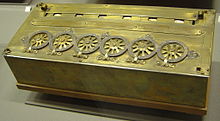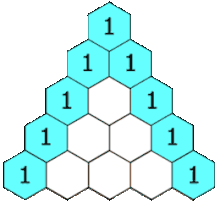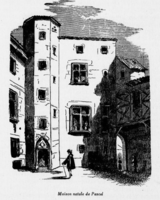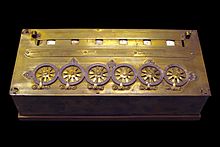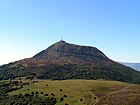| |
布莱兹‧帕斯卡(Blaise Pascal,1623年6月19日-1662年8月19日),法国神学家、哲学家、数学家、物理学家、化学家、音乐家、教育家、气象学家。帕斯卡早期进行自然和应用科学的研究,对机械计算器的制造和流体的研究作出重要贡献,扩展托里切利的工作,澄清了压强和真空的概念。帕斯卡还有力地为科学方法辩护。数学上,帕斯卡促成了两个重要的新研究领域。他16岁写出一篇题为射影几何的论文,1654年开始与皮埃尔·德·费马通信,讨论概率论,深刻影响了现代经济学和社会科学的发展。
1654年末一次信仰上的神秘经历后,他离开数学和物理学,专注于沉思和神学与哲学写作。他是坚定的詹森教派信徒,人文思想大受蒙田影响。宗教论战之作《致外省人书》(Lettres provinciales)被奉为法文写作的典范,身后其笔记本被编为《思想录》。
早期的生活和教育
帕斯卡出生于克莱蒙费朗,三岁丧母。他的父亲艾蒂安·帕斯卡(1588–1651),在科学和数学上有着很大的兴趣,是一名罗勃贵族和当地法官。帕斯卡有2名姊妹,妹妹叫杰奎琳,姐姐叫洁柏特。1631年,在他的妻子死亡五年后,艾蒂安和他的孩子们搬到了巴黎。这个新抵达的家庭马上就聘请了一位女佣,露易丝‧迪佛特,而她最后并成为了这家庭重要的一位成员。艾蒂安从未再娶,由于他的孩子们都展现出杰出的智慧,所以他决定他将要独自教育他们,尤其是展现出数学和科学上惊人的天分的儿子布莱兹‧帕斯卡。
在他11岁那年,他创作了一篇有关于身体振动发出声音的论文,然后艾蒂安便在他儿子15岁前禁止他继续追求数学知识,以免他荒废拉丁语和希腊文的学习。不过有一天,艾蒂安发现布莱兹(12岁)正用一块木炭在墙壁上写一项独立证明,即三角形的角度总和会等于两个直角相加。从那时起,这个男孩便被允许学习欧几里得几何学,以及在默桑神父修道院旁听一些欧洲杰出的数学家和科学家,例如罗贝瓦尔、吉拉德·笛沙格、迈多治、伽桑狄,和笛卡尔。
吉拉德·笛沙格的一份关于圆锥曲线的作品尤其让帕斯卡感兴趣,根据德扎格的思想,16岁的帕斯卡写了一篇被称作神秘六边形的短篇论文,Essai pour les coniques(圆锥曲线专论),作为证明的方法,然后将这份他第一次认真创作的数学作品寄到巴黎的马兰·梅森神父,这至今仍被广为称作“帕斯卡定理”。它描述了一个圆锥曲线的内接六边形的三对对边延长线的交点共线,又称帕斯卡线。帕斯卡的作品过于早熟,以至于笛卡尔看了他的手稿后,拒绝相信这是小帕斯卡所写的。当梅森神父保证这份作品为小帕斯卡所写时,笛卡尔嗤之以鼻,说:“我不觉得他给出的关于圆锥的证明比早先的方法更合适这件事有什么奇怪的。”并说:“但关于这份主题的其他东西可以推荐,因为这几乎不会发生在一个16岁的少年身上。”
在当时的法国,办公室和职位是可以买卖的。1631年时,艾蒂安用65,665里弗(livres)卖出了他在间接税法院副总裁的职位。这笔钱被投资在政府基金,如果不浪费的话,必定会成为一笔丰厚的收入而能让帕斯卡家族可以搬到巴黎并好好享受那里的生活。但在1638年,黎塞留急需钱来供应三十年战争的开销,拖欠了政府基金的发放,于是艾蒂安·帕斯卡的财产一下子从将近66000里弗降到少于7300里弗。就像许多人一样,因为反对黎塞留的税务政策,艾蒂安被迫逃离巴黎,留下他三个孩子给邻居珊卡特女士照顾。她是一位有着坏名声的美女,据说拥有全法国最奢华的启蒙沙龙。艾蒂安一直到杰奎琳在一场黎塞留有出席的儿童戏剧表演中表现出众才被赦免。在当时艾蒂安也重获枢机主教的青睐,并在1639年时,被指派为国王的税务专员,前往一个因革命而税制陷入极端混乱的城市—鲁昂。
1642年,为了减轻他父亲无止尽地、重复地计算税务的收支负担,未满19岁的帕斯卡努力地制造出一台可以运行加减的计算器,称为帕斯卡计算器。而在巴黎工艺美术博物馆和德国德累斯顿的茨温格博物馆,展示着他原创的两台计算器。虽然这些机械后来成为早期电脑工程的先驱,但在当时并没有造成很大的商业成功。因为它实在是太过昂贵以致于变得比较像是件玩具,和非常有钱的法国或欧洲人展示地位的象征。然而帕斯卡在下个十年仍然不断的精进他的设计,并且总共做了20台这样的机器。
对数学的贡献
帕斯卡的一生都在影响数学研究。他在1653年的《论算术三角》中描述了一个二项式系数的表格表示,表中的每个数都等于其肩上的两个数的和,现在被称作帕斯卡三角。
在1654年,在一个热衷于赌博问题的朋友的影响下,他和费马通信讨论,并因此诞生了数学理论概率论。这个朋友的具体问题是:基于赢得赌局的概率,两个提前结束游戏的玩家如何在给定现在赌局的情形下公平的分赌注。期望的概念在这一讨论中提出。费马和帕斯卡完成的分析和概率的工作给莱布尼茨提出无穷小微积分奠定了基础。1654年后受宗教经历影响,帕斯卡几乎放弃了数学工作。
去世
1662年,帕斯卡病情加重,情绪状况也因前几年姐姐的死恶化了许多。帕斯卡注意到自己即将逝去,便寻求医院来解决他的不治之症,但却被他的医生拒绝了,原因是他的状况实在是太不稳定以致于难以照顾。1662年8月18日的巴黎,帕斯卡开始抽搐且进入了临终。1662年8月19日清晨,帕斯卡去世,埋在圣艾蒂安教堂的坟墓里。
一份尸检报告指出,帕斯卡的胃及其他腹部器官都有着很严重的问题,脑部也有受损。然而,造成这种状况的原因仍然无法确定,虽然推测可能是肺结核或胃癌,也有可能是两者共同导致。而时常折磨著帕斯卡的头痛则一般被归因于脑的病变。
作品
- 《圆锥曲线专论》(1639)
- 《关于真空的新实验》(1647)
- 《算数三角形》(1653)
- 《致外省人书》(1656-57)
- 《几何的精神》(1657或1658)
- 《写在签名的形式》(1661)
- 《思想录》(未完成即死亡)
- 《人类幸福》
杂项
- 在法国,年度杰出奖颁给布莱兹‧帕斯卡‧查尔斯全国杰出科学家奖以进行他们在法兰西岛的研究。
- 一座位于克莱蒙-费朗的大学,以帕斯卡的名字命名为布莱兹‧帕斯卡大学。
- 加拿大安大略省的滑铁卢大学每年都会举办一场以他命名的数学竞赛。帕斯卡竞赛开放给世界上每一位年龄在15岁或9年级以下的学生参加。
- 罗伯托·罗塞里尼导演了一部传记式的电影(标题为布莱兹‧帕斯卡),在1971在意大利开始播送。
- 帕斯卡在1984年BBC Two第一版的纪录片《海洋的真相》里成为主题,由克匹特饰演。
- 一种结构化计算机编程语言帕斯卡语言为纪念他而命名。
参考文献
- ^ Devlin, Keith, The Unfinished Game: Pascal, Fermat, and the Seventeenth-Century Letter that Made the World Modern, Basic Books; 1 edition (2008), ISBN 978-0-465-00910-7, p. 20.
- ^ O'Connor, J.J.; Robertson, E.F. Étienne Pascal. University of St. Andrews, Scotland. August 2006 [5 February 2010]. (原始内容存档于2017-11-08).
- ^ ^ O'Connor, J. J.; Robertson, E. F.. "The MacTutor History of Mathematics archive: Pierre de Fermat". http://www-groups.dcs.st-and.ac.uk/~history/Biographies/Fermat.html 页面存档备份,存于互联网档案馆
Blaise Pascal (/pæˈskæl/ pask-AL, also UK: /-ˈskɑːl, ˈpæskəl, -skæl/ -AHL, PASK-əl, -al, US: /pɑːˈskɑːl/ pah-SKAHL; French: [blɛz paskal]; 19 June 1623 – 19 August 1662) was a French mathematician, physicist, inventor, philosopher, writer and Catholic theologian.
He was a child prodigy who was educated by his father, a tax collector in Rouen. Pascal's earliest mathematical work was on the conics sections; he wrote a significant treatise on the subject of projective geometry at the age of 16. He later corresponded with Pierre de Fermat on probability theory, strongly influencing the development of modern economics and social science. In 1642, while still a teenager, he started some pioneering work on calculating machines (called Pascal's calculators and later Pascalines), establishing him as one of the first two inventors of the mechanical calculator.
He also worked in the natural and applied sciences, where he made important contributions to the study of fluids, and clarified the concepts of pressure and vacuum by generalising the work of Evangelista Torricelli. Following Galileo Galilei and Torricelli, in 1647, he rebutted Aristotle's followers who insisted that nature abhors a vacuum. Pascal's results caused many disputes before being accepted. Pascal also wrote in defense of the scientific method.
In 1646, he and his sister Jacqueline identified with the religious movement within Catholicism known by its detractors as Jansenism. Following a religious experience in late 1654, he began writing influential works on philosophy and theology. His two most famous works date from this period: the Lettres provinciales and the Pensées, the former set in the conflict between Jansenists and Jesuits. The latter contains Pascal's Wager, a probabilistic argument for God's existence. In that year, he also wrote an important treatise on the arithmetical triangle. Between 1658 and 1659, he wrote on the cycloid and its use in calculating the volume of solids.
Throughout his life, Pascal was in frail health, especially after the age of 18; he died just two months after his 39th birthday.
Early life and education
Pascal was born in Clermont-Ferrand, which is in France's Auvergne region, by the Massif Central. He lost his mother, Antoinette Begon, at the age of three. His father, Étienne Pascal (1588–1651), who also had an interest in science and mathematics, was a local judge and member of the "Noblesse de Robe". Pascal had two sisters, the younger Jacqueline and the elder Gilberte.
In 1631, five years after the death of his wife, Étienne Pascal moved with his children to Paris. The newly arrived family soon hired Louise Delfault, a maid who eventually became an instrumental member of the family. Étienne, who never remarried, decided that he alone would educate his children, for they all showed extraordinary intellectual ability, particularly his son Blaise. The young Pascal showed an amazing aptitude for mathematics and science.
Essay on Conics
Particularly of interest to Pascal was a work of Desargues on conic sections. Following Desargues' thinking, the 16-year-old Pascal produced, as a means of proof, a short treatise on what was called the "Mystic Hexagram", "Essai pour les coniques" ("Essay on Conics") and sent it—his first serious work of mathematics—to Père Mersenne in Paris; it is known still today as Pascal's theorem. It states that if a hexagon is inscribed in a circle (or conic) then the three intersection points of opposite sides lie on a line (called the Pascal line).
Pascal's work was so precocious that Descartes was convinced that Pascal's father had written it. When assured by Mersenne that it was, indeed, the product of the son and not the father, Descartes dismissed it with a sniff: "I do not find it strange that he has offered demonstrations about conics more appropriate than those of the ancients," adding, "but other matters related to this subject can be proposed that would scarcely occur to a 16-year-old child."
Leaving Paris
In France at that time offices and positions could be—and were—bought and sold. In 1631, Étienne sold his position as second president of the Cour des Aides for 65,665 livres. The money was invested in a government bond which provided, if not a lavish, then certainly a comfortable income which allowed the Pascal family to move to, and enjoy, Paris. But in 1638 Richelieu, desperate for money to carry on the Thirty Years' War, defaulted on the government's bonds. Suddenly Étienne Pascal's worth had dropped from nearly 66,000 livres to less than 7,300.
Like so many others, Étienne was eventually forced to flee Paris because of his opposition to the fiscal policies of Cardinal Richelieu, leaving his three children in the care of his neighbour Madame Sainctot, a great beauty with an infamous past who kept one of the most glittering and intellectual salons in all France. It was only when Jacqueline performed well in a children's play with Richelieu in attendance that Étienne was pardoned. In time, Étienne was back in good graces with the cardinal and in 1639 had been appointed the king's commissioner of taxes in the city of Rouen—a city whose tax records, thanks to uprisings, were in utter chaos.
Pascaline
In 1642, in an effort to ease his father's endless, exhausting calculations, and recalculations, of taxes owed and paid (into which work the young Pascal had been recruited), Pascal, not yet 19, constructed a mechanical calculator capable of addition and subtraction, called Pascal's calculator or the Pascaline. Of the eight Pascalines known to have survived, four are held by the Musée des Arts et Métiers in Paris and one more by the Zwinger museum in Dresden, Germany, exhibit two of his original mechanical calculators.
Although these machines are pioneering forerunners to a further 400 years of development of mechanical methods of calculation, and in a sense to the later field of computer engineering, the calculator failed to be a great commercial success. Partly because it was still quite cumbersome to use in practice, but probably primarily because it was extraordinarily expensive, the Pascaline became little more than a toy, and a status symbol, for the very rich both in France and elsewhere in Europe. Pascal continued to make improvements to his design through the next decade, and he refers to some 50 machines that were built to his design. he built 20 finished machines over the following 10 years
Mathematics
Pascal continued to influence mathematics throughout his life. The University of Waterloo, Ontario, Canada, holds an annual math contest named in Pascal's honour.
Probability
Pascal's development of probability theory was his most influential contribution to mathematics. Originally applied to gambling, today it is extremely important in economics, especially in actuarial science. John Ross writes, "Probability theory and the discoveries following it changed the way we regard uncertainty, risk, decision-making, and an individual's and society's ability to influence the course of future events." However, Pascal and Fermat, though doing important early work in probability theory, did not develop the field very far. Christiaan Huygens, learning of the subject from the correspondence of Pascal and Fermat, wrote the first book on the subject. Later figures who continued the development of the theory include Abraham de Moivre and Pierre-Simon Laplace.
In 1654, prompted by his friend the Chevalier de Méré, he corresponded with Pierre de Fermat on the subject of gambling problems, and from that collaboration was born the mathematical theory of probabilities. The specific problem was that of two players who want to finish a game early and, given the current circumstances of the game, want to divide the stakes fairly, based on the chance each has of winning the game from that point. From this discussion, the notion of expected value was introduced. Pascal later (in the Pensées) used a probabilistic argument, Pascal's wager, to justify belief in God and a virtuous life. The work done by Fermat and Pascal into the calculus of probabilities laid important groundwork for Leibniz' formulation of the calculus.
Pascal's triangle
Pascal's Traité du triangle arithmétique ("Treatise on the Arithmetical Triangle") of 1654 described a convenient tabular presentation for binomial coefficients, now called Pascal's triangle. The triangle can also be represented:
| 0 | 1 | 2 | 3 | 4 | 5 | 6 | |
|---|---|---|---|---|---|---|---|
| 0 | 1 | 1 | 1 | 1 | 1 | 1 | 1 |
| 1 | 1 | 2 | 3 | 4 | 5 | 6 | |
| 2 | 1 | 3 | 6 | 10 | 15 | ||
| 3 | 1 | 4 | 10 | 20 | |||
| 4 | 1 | 5 | 15 | ||||
| 5 | 1 | 6 | |||||
| 6 | 1 |
He defines the numbers in the triangle by recursion: Call the number in the (m + 1)th row and (n + 1)th column tmn. Then tmn = tm–1,n + tm,n–1, for m = 0, 1, 2, ... and n = 0, 1, 2, ... The boundary conditions are tm,−1 = 0, t−1,n = 0 for m = 1, 2, 3, ... and n = 1, 2, 3, ... The generator t00 = 1. Pascal concludes with the proof,
In 1654, he proved Pascal's identity relating the sums of the p-th powers of the first n positive integers for p = 0, 1, 2,..., k. That same year, Pascal had a religious experience, and mostly gave up work in mathematics.
Cycloid
In 1658, Pascal, while suffering from a toothache, began considering several problems concerning the cycloid. His toothache disappeared, and he took this as a heavenly sign to proceed with his research. Eight days later he had completed his essay and, to publicize the results, proposed a contest.
Pascal proposed three questions relating to the center of gravity, area and volume of the cycloid, with the winner or winners to receive prizes of 20 and 40 Spanish doubloons. Pascal, Gilles de Roberval and Pierre de Carcavi were the judges, and neither of the two submissions (by John Wallis and Antoine de Lalouvère) were judged to be adequate. While the contest was ongoing, Christopher Wren sent Pascal a proposal for a proof of the rectification of the cycloid; Roberval claimed promptly that he had known of the proof for years. Wallis published Wren's proof (crediting Wren) in Wallis's Tractus Duo, giving Wren priority for the first published proof.
Physics
Pascal contributed to several fields in physics, most notably the fields of fluid mechanics and pressure. In honour of his scientific contributions, the name Pascal has been given to the SI unit of pressure and Pascal's law (an important principle of hydrostatics). He introduced a primitive form of roulette and the roulette wheel in his search for a perpetual motion machine.
Fluid dynamics
His work in the fields of hydrodynamics and hydrostatics centered on the principles of hydraulic fluids. His inventions include the hydraulic press (using hydraulic pressure to multiply force) and the syringe. He proved that hydrostatic pressure depends not on the weight of the fluid but on the elevation difference. He demonstrated this principle by attaching a thin tube to a barrel full of water and filling the tube with water up to the level of the third floor of a building. This caused the barrel to leak, in what became known as Pascal's barrel experiment.
Vacuum
By 1647, Pascal had learned of Evangelista Torricelli's experimentation with barometers. Having replicated an experiment that involved placing a tube filled with mercury upside down in a bowl of mercury, Pascal questioned what force kept some mercury in the tube and what filled the space above the mercury in the tube. At the time, most scientists including Descartes believed in a plenum, i. e. some invisible matter filled all of space, rather than a vacuum. "Nature abhors a vacuum." This was based on the Aristotelian notion that everything in motion was a substance, moved by another substance. Furthermore, light passed through the glass tube, suggesting a substance such as aether rather than vacuum filled the space.
Following more experimentation in this vein, in 1647 Pascal produced Experiences nouvelles touchant le vide ("New experiments with the vacuum"), which detailed basic rules describing to what degree various liquids could be supported by air pressure. It also provided reasons why it was indeed a vacuum above the column of liquid in a barometer tube. This work was followed by Récit de la grande expérience de l'équilibre des liqueurs ("Account of the great experiment on equilibrium in liquids") published in 1648.
The Torricellian vacuum found that air pressure is equal to the weight of 30 inches of mercury. If air has a finite weight, Earth's atmosphere must have a maximum height. Pascal reasoned that if true, air pressure on a high mountain must be less than at a lower altitude. He lived near the Puy de Dôme mountain, 4,790 feet (1,460 m) tall, but his health was poor so could not climb it. On 19 September 1648, after many months of Pascal's friendly but insistent prodding, Florin Périer, husband of Pascal's elder sister Gilberte, was finally able to carry out the fact-finding mission vital to Pascal's theory. The account, written by Périer, reads:
Pascal replicated the experiment in Paris by carrying a barometer up to the top of the bell tower at the church of Saint-Jacques-de-la-Boucherie, a height of about 50 metres. The mercury dropped two lines.
In a reply to the plenist Estienne Noel, Pascal wrote, echoing contemporary notions of science and falsifiability: "In order to show that a hypothesis is evident, it does not suffice that all the phenomena follow from it; instead, if it leads to something contrary to a single one of the phenomena, that suffices to establish its falsity."
Blaise Pascal Chairs are given to outstanding international scientists to conduct their research in the Ile de France region.
Adult life: religion, literature, and philosophy
Religious conversion
In the winter of 1646, Pascal's 58-year-old father broke his hip when he slipped and fell on an icy street of Rouen; given the man's age and the state of medicine in the 17th century, a broken hip could be a very serious condition, perhaps even fatal. Rouen was home to two of the finest doctors in France: Monsieur Doctor Deslandes and Monsieur Doctor de La Bouteillerie. The elder Pascal "would not let anyone other than these men attend him...It was a good choice, for the old man survived and was able to walk again..." But treatment and rehabilitation took three months, during which time La Bouteillerie and Deslandes had become regular visitors.
Both men were followers of Jean Guillebert, proponent of a splinter group from Catholic teaching known as Jansenism. This still fairly small sect was making surprising inroads into the French Catholic community at that time. It espoused rigorous Augustinism. Blaise spoke with the doctors frequently, and after their successful treatment of his father, borrowed from them works by Jansenist authors. In this period, Pascal experienced a sort of "first conversion" and began to write on theological subjects in the course of the following year.
Pascal fell away from this initial religious engagement and experienced a few years of what some biographers have called his "worldly period" (1648–54). His father died in 1651 and left his inheritance to Pascal and his sister Jacqueline, for whom Pascal acted as conservator. Jacqueline announced that she would soon become a postulant in the Jansenist convent of Port-Royal. Pascal was deeply affected and very sad, not because of her choice, but because of his chronic poor health; he needed her just as she had needed him.
By the end of October in 1651, a truce had been reached between brother and sister. In return for a healthy annual stipend, Jacqueline signed over her part of the inheritance to her brother. Gilberte had already been given her inheritance in the form of a dowry. In early January, Jacqueline left for Port-Royal. On that day, according to Gilberte concerning her brother, "He retired very sadly to his rooms without seeing Jacqueline, who was waiting in the little parlor..." In early June 1653, after what must have seemed like endless badgering from Jacqueline, Pascal formally signed over the whole of his sister's inheritance to Port-Royal, which, to him, "had begun to smell like a cult." With two-thirds of his father's estate now gone, the 29-year-old Pascal was now consigned to genteel poverty.
For a while, Pascal pursued the life of a bachelor. During visits to his sister at Port-Royal in 1654, he displayed contempt for affairs of the world but was not drawn to God.
The Memorial
On the 23 of November, 1654, between 10:30 and 12:30 at night, Pascal had an intense religious experience and immediately wrote a brief note to himself which began: "Fire. God of Abraham, God of Isaac, God of Jacob, not of the philosophers and the scholars..." and concluded by quoting Psalm 119:16: "I will not forget thy word. Amen." He seems to have carefully sewn this document into his coat and always transferred it when he changed clothes; a servant discovered it only by chance after his death. This piece is now known as the Memorial. The story of a carriage accident as having led to the experience described in the Memorial is disputed by some scholars. His belief and religious commitment revitalized, Pascal visited the older of two convents at Port-Royal for a two-week retreat in January 1655. For the next four years, he regularly travelled between Port-Royal and Paris. It was at this point immediately after his conversion when he began writing his first major literary work on religion, the Provincial Letters.
Literature
In literature, Pascal is regarded as one of the most important authors of the French Classical Period and is read today as one of the greatest masters of French prose. His use of satire and wit influenced later polemicists.
The Provincial Letters
Beginning in 1656–57, Pascal published his memorable attack on casuistry, a popular ethical method used by Catholic thinkers in the early modern period (especially the Jesuits, and in particular Antonio Escobar). Pascal denounced casuistry as the mere use of complex reasoning to justify moral laxity and all sorts of sins. The 18-letter series was published between 1656 and 1657 under the pseudonym Louis de Montalte and incensed Louis XIV. The king ordered that the book be shredded and burnt in 1660. In 1661, in the midsts of the formulary controversy, the Jansenist school at Port-Royal was condemned and closed down; those involved with the school had to sign a 1656 papal bull condemning the teachings of Jansen as heretical. The final letter from Pascal, in 1657, had defied Alexander VII himself. Even Pope Alexander, while publicly opposing them, nonetheless was persuaded by Pascal's arguments.
Aside from their religious influence, the Provincial Letters were popular as a literary work. Pascal's use of humor, mockery, and vicious satire in his arguments made the letters ripe for public consumption, and influenced the prose of later French writers like Voltaire and Jean-Jacques Rousseau.
It is in the Provincial Letters that Pascal made his oft-quoted apology for writing a long letter, as he had not had time to write a shorter one. From Letter XVI, as translated by Thomas M'Crie: 'Reverend fathers, my letters were not wont either to be so prolix, or to follow so closely on one another. Want of time must plead my excuse for both of these faults. The present letter is a very long one, simply because I had no leisure to make it shorter.'
Charles Perrault wrote of the Letters: "Everything is there—purity of language, nobility of thought, solidity in reasoning, finesse in raillery, and throughout an agrément not to be found anywhere else."
Philosophy
Pascal is arguably best known as a philosopher, considered by some the second greatest French mind behind René Descartes. He was a dualist following Descartes. However, he is also remembered for his opposition to both the rationalism of the likes of Descartes and simultaneous opposition to the main countervailing epistemology, empiricism, preferring fideism.
He cared above all about the philosophy of religion. Pascalian theology has grown out of his perspective that humans are, according to Wood, "born into a duplicitous world that shapes us into duplicitous subjects and so we find it easy to reject God continually and deceive ourselves about our own sinfulness".
Philosophy of mathematics
Pascal's major contribution to the philosophy of mathematics came with his De l'Esprit géométrique ("Of the Geometrical Spirit"), originally written as a preface to a geometry textbook for one of the famous Petites écoles de Port-Royal ("Little Schools of Port-Royal"). The work was unpublished until over a century after his death. Here, Pascal looked into the issue of discovering truths, arguing that the ideal of such a method would be to found all propositions on already established truths. At the same time, however, he claimed this was impossible because such established truths would require other truths to back them up—first principles, therefore, cannot be reached. Based on this, Pascal argued that the procedure used in geometry was as perfect as possible, with certain principles assumed and other propositions developed from them. Nevertheless, there was no way to know the assumed principles to be true.
Pascal also used De l'Esprit géométrique to develop a theory of definition. He distinguished between definitions which are conventional labels defined by the writer and definitions which are within the language and understood by everyone because they naturally designate their referent. The second type would be characteristic of the philosophy of essentialism. Pascal claimed that only definitions of the first type were important to science and mathematics, arguing that those fields should adopt the philosophy of formalism as formulated by Descartes.
In De l'Art de persuader ("On the Art of Persuasion"), Pascal looked deeper into geometry's axiomatic method, specifically the question of how people come to be convinced of the axioms upon which later conclusions are based. Pascal agreed with Montaigne that achieving certainty in these axioms and conclusions through human methods is impossible. He asserted that these principles can be grasped only through intuition, and that this fact underscored the necessity for submission to God in searching out truths.
The Pensées
- Blaise Pascal, Pensées No. 200
Pascal's most influential theological work, referred to posthumously as the Pensées ("Thoughts") is widely considered to be a masterpiece, and a landmark in French prose. When commenting on one particular section (Thought #72), Sainte-Beuve praised it as the finest pages in the French language. Will Durant hailed the Pensées as "the most eloquent book in French prose".
The Pensées was not completed before his death. It was to have been a sustained and coherent examination and defense of the Christian faith, with the original title Apologie de la religion Chrétienne ("Defense of the Christian Religion"). The first version of the numerous scraps of paper found after his death appeared in print as a book in 1669 titled Pensées de M. Pascal sur la religion, et sur quelques autres sujets ("Thoughts of M. Pascal on religion, and on some other subjects") and soon thereafter became a classic.
One of the Apologie's main strategies was to use the contradictory philosophies of Pyrrhonism and Stoicism, personalized by Montaigne on one hand, and Epictetus on the other, in order to bring the unbeliever to such despair and confusion that he would embrace God.
Last works and death
T. S. Eliot described him during this phase of his life as "a man of the world among ascetics, and an ascetic among men of the world." Pascal's ascetic lifestyle derived from a belief that it was natural and necessary for a person to suffer. In 1659, Pascal fell seriously ill. During his last years, he frequently tried to reject the ministrations of his doctors, saying, "Sickness is the natural state of Christians."
Louis XIV suppressed the Jansenist movement at Port-Royal in 1661. In response, Pascal wrote one of his final works, Écrit sur la signature du formulaire ("Writ on the Signing of the Form"), exhorting the Jansenists not to give in. Later that year, his sister Jacqueline died, which convinced Pascal to cease his polemics on Jansenism. Pascal's last major achievement, returning to his mechanical genius, was inaugurating perhaps the first bus line, the carrosses à cinq sols, moving passengers within Paris in a carriage with many seats.
In 1662, Pascal's illness became more violent, and his emotional condition had severely worsened since his sister's death. Aware that his health was fading quickly, he sought a move to the hospital for incurable diseases, but his doctors declared that he was too unstable to be carried. In Paris on 18 August 1662, Pascal went into convulsions and received extreme unction. He died the next morning, his last words being "May God never abandon me," and was buried in the cemetery of Saint-Étienne-du-Mont.
An autopsy performed after his death revealed grave problems with his stomach and other organs of his abdomen, along with damage to his brain. Despite the autopsy, the cause of his poor health was never precisely determined, though speculation focuses on tuberculosis, stomach cancer, or a combination of the two. The headaches which afflicted Pascal are generally attributed to his brain lesion.
Popular culture and references
Schools
One of the Universities of Clermont-Ferrand, France – Université Blaise Pascal – is named after him. Établissement scolaire français Blaise-Pascal in Lubumbashi, Democratic Republic of the Congo is named after Pascal.
Film
The 1969 Eric Rohmer film My Night at Maud's is based on the work of Pascal. Roberto Rossellini directed a filmed biopic, Blaise Pascal, which originally aired on Italian television in 1971. Pascal was a subject of the first edition of the 1984 BBC Two documentary, Sea of Faith, presented by Don Cupitt. The chameleon in the film Tangled is named for Pascal.
Computing
A programming language is named for Pascal. In 2014, Nvidia announced its new Pascal microarchitecture, which is named for Pascal. The first graphics cards featuring Pascal were released in 2016.
Video games
The 2017 game Nier: Automata has multiple characters named after famous philosophers; one of these is a sentient pacifistic machine named Pascal, who serves as a major supporting character. Pascal creates a village for machines to live peacefully with the androids they're at war with and acts as a parental figure for other machines trying to adapt to their newly-found individuality.
The otter in the Animal Crossing series is named for Pascal.
Works
- "Essai pour les coniques" [Essay on conics] (1639)
- Experiences nouvelles touchant le vide [New experiments with the vacuum] (1647)
- Récit de la grande expérience de l'équilibre des liqueurs [Account of the great experiment on equilibrium in liquids] (1648)
- Traité du triangle arithmétique [Treatise on the arithmetical triangle] (written c. 1654; publ. 1665)
- Lettres provinciales [The provincial letters] (1656–57)
- De l'Esprit géométrique [On the geometrical spirit] (1657 or 1658)
- Écrit sur la signature du formulaire (1661)
- Pensées [Thoughts] (incomplete at death; publ. 1670)

